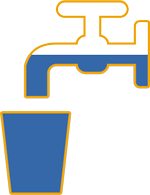Back to all Research Results
Pharmaceuticals
Research Question: What happens to the medicine in our urine?
Dates: ongoing
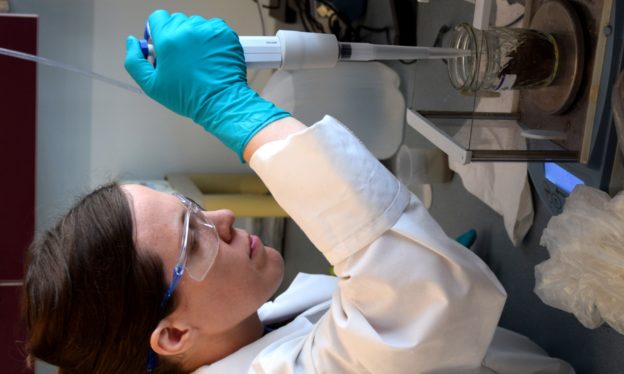
Pharmaceuticals have lives of their own once our bodies are done with them. The medications and drugs we take or coffee we imbibe each morning enter our bloodstream, are filtered out by our kidneys and digestive system, and ultimately excreted in the form of both urine (~64%) and feces (~35%). But you might not think about where their journey takes them next.
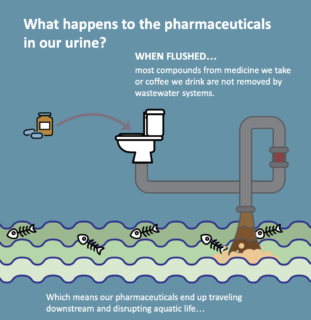 If you flush your urine, pharmaceuticals are passed on to a wastewater treatment plant or septic system. These two approaches to wastewater management were designed with the primary purpose of controlling the spread of pathogens (biological disease-causing agents) and neither is very good at removing the plethora of chemicals that we send their way. Many pharmaceutically active compounds travel through these systems largely unchanged, which is why they are commonly found in downstream water bodies.
If you flush your urine, pharmaceuticals are passed on to a wastewater treatment plant or septic system. These two approaches to wastewater management were designed with the primary purpose of controlling the spread of pathogens (biological disease-causing agents) and neither is very good at removing the plethora of chemicals that we send their way. Many pharmaceutically active compounds travel through these systems largely unchanged, which is why they are commonly found in downstream water bodies.
Pharmaceuticals have various disruptive effects on aquatic species–from disorienting eels, to emboldening crayfish, to causing shrimp to swim toward the light. Pharmaceuticals in waterways can also enter drinking water sources for human communities, with largely unknown effects. By collecting urine and keeping it out of the wastewater stream, we can contain the pharmaceuticals before they reach sensitive aquatic ecosystems and water supplies.
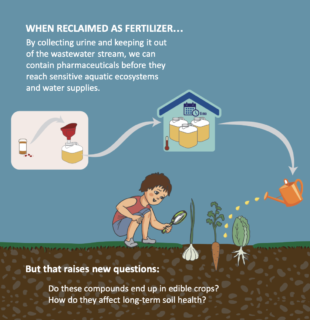 When urine is applied to agricultural soil, as Rich Earth does with the urine we collect and pasteurize, soil microbes have the opportunity to break down many of the pharmaceuticals that, if flushed, would otherwise be sent to sewage treatment plants or septic systems. So, perhaps counterintuitively, applying urine to cropland can control pharmaceuticals better than flushing them downstream, with benefits for both human and environmental health.
When urine is applied to agricultural soil, as Rich Earth does with the urine we collect and pasteurize, soil microbes have the opportunity to break down many of the pharmaceuticals that, if flushed, would otherwise be sent to sewage treatment plants or septic systems. So, perhaps counterintuitively, applying urine to cropland can control pharmaceuticals better than flushing them downstream, with benefits for both human and environmental health.
But that raises new questions, including whether these pharmaceuticals end up in edible crops and how they might affect long-term soil health. These are some of the most common concerns that people have raised about this practice. The Rich Earth team has been dedicated to better understanding these questions since our organization’s founding.
Our research
From 2014-2020, Rich Earth conducted multiple field and lab trials looking at the fate of pharmaceuticals in urine, in partnership with the University of Michigan, the University at Buffalo, and the Hampton Roads Sanitation District. Specifically, we studied the presence and persistence of pharmaceuticals in urine-derived fertilizers, soils, groundwater, and crop tissues.
So far, we have tested 20 different pharmaceuticals and 2 metabolites. In the final year of research we also added 3 natural hormones (estrone, estradiol, and estriol), and one synthetic hormone (ethinylestradiol), for a total of 26 different compounds. These pharmaceuticals and metabolites were chosen to represent a diversity of types of medication as well as a variety of chemical properties. The amounts and concentrations used were based on the highest levels that has been found in a community wastewater system, based on the scientific literature.
Results
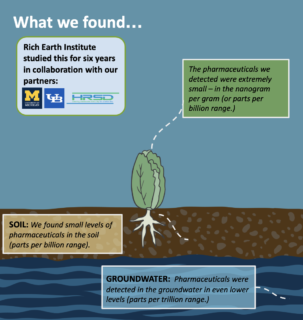 Our research has consistently found that while there are some pharmaceuticals detectable in crop tissue, the levels are extremely small–in the nanogram per gram (or parts per billion / ppb) range. We have not detected any hormones in plant tissue. The final report is still in progress and will be posted here when it is completed. Additionally, a study on bacterial convergence in urine can be found here, and these two academic posters outlining methods and results provide preliminary information about this study of pharmaceutical levels in soil, water, and plants.
Our research has consistently found that while there are some pharmaceuticals detectable in crop tissue, the levels are extremely small–in the nanogram per gram (or parts per billion / ppb) range. We have not detected any hormones in plant tissue. The final report is still in progress and will be posted here when it is completed. Additionally, a study on bacterial convergence in urine can be found here, and these two academic posters outlining methods and results provide preliminary information about this study of pharmaceutical levels in soil, water, and plants.
What does this mean for me?
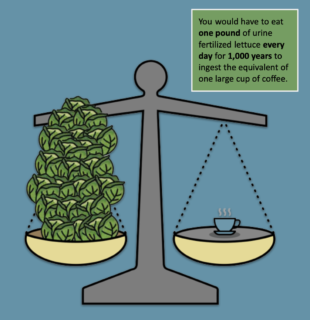 Perhaps unsurprisingly, caffeine is by far the most abundant drug found in human urine. But the molecule is present in such tiny amounts in urine-fertilized lettuce that you would have to eat a pound every day for 2,000 years in order to ingest the equivalent of two large cups of coffee. Likewise, a person would need to eat a pound of urine-fertilized lettuce every day for 2,000 years to ingest a single dose of acetaminophen (Tylenol). (We use lettuce as an example because it represents a worst-case scenario, since pharmaceuticals are carried to the leaves and concentrated there when water from the roots flows into the leaves and then evaporates).
Perhaps unsurprisingly, caffeine is by far the most abundant drug found in human urine. But the molecule is present in such tiny amounts in urine-fertilized lettuce that you would have to eat a pound every day for 2,000 years in order to ingest the equivalent of two large cups of coffee. Likewise, a person would need to eat a pound of urine-fertilized lettuce every day for 2,000 years to ingest a single dose of acetaminophen (Tylenol). (We use lettuce as an example because it represents a worst-case scenario, since pharmaceuticals are carried to the leaves and concentrated there when water from the roots flows into the leaves and then evaporates).
It is important to note that much of grocery-store produce (including organic) is grown on land fertilized with animal manures, which often contain residues from pharmaceuticals given to livestock. Additionally, treated wastewater plant effluent, with its pre-existing pharmaceutical loads, is used for irrigation (common in arid climates, including on organic farms).
Other researchers have looked at the fate of pharmaceuticals in these situations, and have found results similar to ours: pharmaceuticals are sometimes taken up by crops, but in extremely small amounts, in the nanogram per gram (ng/g) range. Wastewater irrigation results in somewhat higher uptake levels because it usually involves repeated applications closer to harvest time. Still, at this point, our understanding is that the scientific literature indicates these quantities do not represent a significant risk to human health.
Additional Treatment Options
Despite the negligible risk to human health, there are additional treatments that can be used to remove pharmaceuticals from urine. This can be desirable for different reasons depending on the context: perceptions of risk will vary in communities, and effects on soil health are yet unknown (such as longer-term effects on soil microbial diversity.)
Researchers at Rich Earth and elsewhere have tested charcoal filtration as an additional filtration treatment step for urine, and it removes most of the residual pharmaceuticals. Our current treatment train does not include this filtration, but if future study justifies the resources and energy required for this additional treatment treatment, it could be implemented. We remain dedicated to better understanding the effects of pharmaceuticals on soil health, as well as how community perceptions of pharmaceuticals in urine fertilizer may vary.

